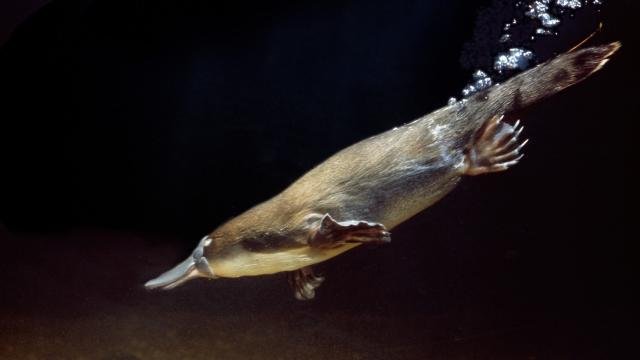The platypus is nature’s crazy quilt, as this strange creature looks like about a half-dozen different animals all rolled into one. Turns out that platypuses were hiding yet another conspicuous feature: THEY CAN FREAKIN’ GLOW IN THE DARK.
It’s not enough to be a mammal who lays eggs, sports a duck-like bill and webbed feet, hunts using electroreception, and wields venomous spurs. The platypus also glows green under ultraviolet light. Because of course it does. Details of this unexpected discovery were published earlier this month in the science journal Mammalia.
The platypus now joins a very exclusive club, as it’s one of only three known biofluorescent mammals, the other two being opossums and flying squirrels. That said, the platypus does stand alone as the only known monotreme, or egg-laying mammal, capable of pulling off this trick (the only other extant monotremes are four species of echidna). Of course, biofluorescence is seen in many other organisms, such as fungi, fish, phytoplankton, reptiles, amphibians, and at least one species of tardigrade.
The same team involved in the new study, led by biologist Paula Spaeth Anich from Northland College, were the ones who discovered biofluorescence in flying squirrels last year. The discovery happened by accident during night surveys of lichens. Their field observations were later confirmed with specimens of flying squirrels kept at a museum.
With this in mind, the scientists decided to try their luck with another nocturnal-crepuscular mammal. Platypuses, like the flying squirrel (and opossums, too), are active during the dim hours of dawn, dusk, and overnight. For the new study, the team analysed three museum platypus specimens (two males and one female) sourced from the Field Museum of Natural History in Chicago and the University of Nebraska State Museum (the IUCN Red List currently describes the platypus as a near threatened species, and with a population trend in decline).
Platypus fur appears brown in visible light, but as the new research shows, their fur glows green or cyan under UV light. So for your next socially distanced cocktail party, you need to tell your friends that platypus fur absorbs UV wavelengths between 200 and 400 nanometres and then gives off visible light between 500 and 600 nanometres, an optical process resulting in fluorescence.
As the paper points out, both males and females appear to exhibit this trait, though the authors advise a smidge of caution, given the paltry sample size. Also, the researchers are “confident that the fluorescence we observed is not a property of museum specimens in general.”
Assuming you still have a captive audience at this cocktail party, you can tell your friends that platypus bioluminescence is likely an adaptation to low light conditions. Their glowing fur could be a way for the species to see and interact with each other at night, when “UV absorbance and fluorescence may be particularly important to mammals,” write the researchers.
The finding is also interesting from an evolutionary perspective. Monotremes, marsupials, and placental mammals (eutherians) split off from a common ancestor some 150 million years ago, when the Triassic was coming to a close. That, dear readers, is a hell of a long time ago, as the descendants of this evolutionary divorce had to then fight their way through the ensuing Jurassic and Cretaceous periods, not to mention the mass extinction that wiped out all non-avian dinosaurs. That’s a lot of time and lot of possible evolution.
[referenced id=”1519876″ url=”https://gizmodo.com.au/2020/10/newly-discovered-glowing-tardigrade-is-weirdly-resistant-to-lethal-doses-of-uv-radiation/” thumb=”https://gizmodo.com.au/wp-content/uploads/2020/10/15/dz8j0vm3pcsxoccnzkzz-300×169.jpg” title=”Newly Discovered Glowing Tardigrade Is Weirdly Resistant to Lethal Doses of UV Radiation” excerpt=”A newly discovered species of tardigrade that glows blue when exposed to ultraviolet light uses the powers of fluorescence as a protective shield, according to new research.”]
In a De Gruyter press release, Anich said that “it was intriguing to see that animals that were such distant relatives also had biofluorescent fur.” The authors close their paper with a related question: “Is biofluorescence an ancestral mammalian trait?”
Hard to know. If these three wildly disparate groups of mammals retained this trait after 150 million years, it means the genes responsible for biofluorescent fur are highly conserved, in the parlance of biologists. It’s not impossible, but another reasonable explanation is that these three species — opossum, flying squirrel, and platypus — acquired their glowing fur independently as a consequence of convergent evolution. In nature, a good idea is a good idea, which is why common traits can appear in unrelated species.
This latest discovery could also mean that bioluminescence in mammals is not as rare as we think it is. And indeed, this is exactly where the team is headed next, in their quest to find more mammals capable of glowing in the dark.
